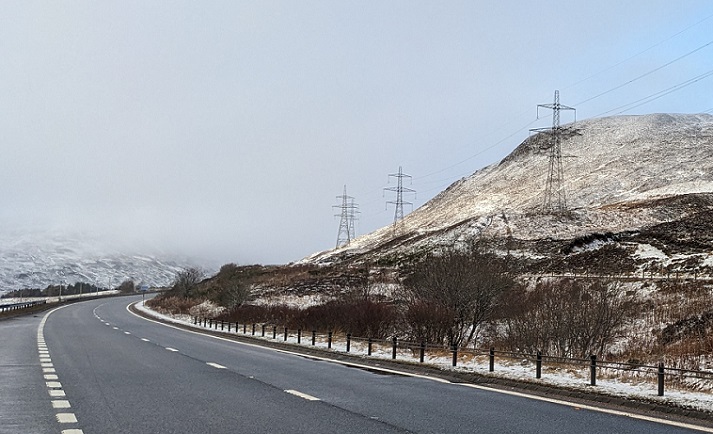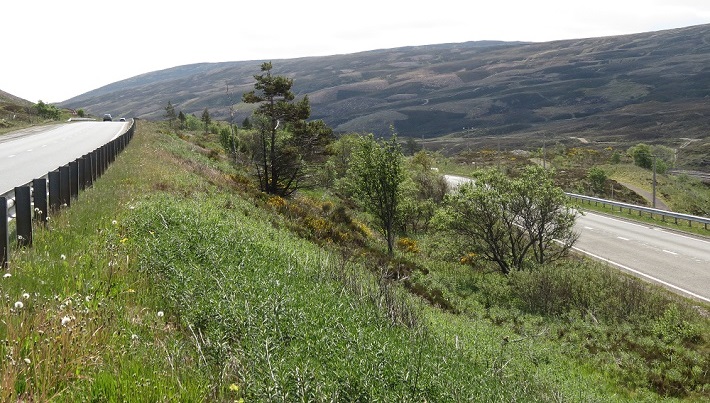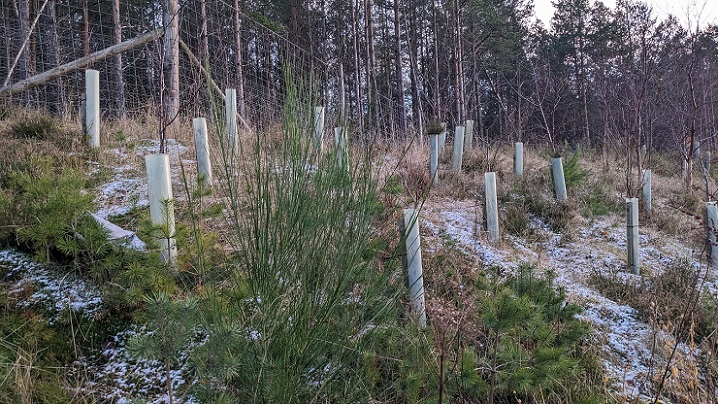
A few days ago Lesley Riddoch posted some excellent drone footage from Lettoch Films (see here) of the woodland that has developed in the central reservation of the A9 between Bruar and Drumochter. Most of the trees and other plants have spread there through natural regeneration and were able to do so because of the absence of grazing pressure and muirburn that blights much of the upland areas of Scotland.

The speed with which trees colonised the area will have been helped by the mineral soils created by the construction of the road but the key point is that the area is evolving into woodland without any human intervention. You can similar examples of this along the edges of roads all over Scotland, particularly but not exclusively where there are deer fences to prevent deer causing accidents.

The ground disturbed by the construction of the Beauly Denny powerline ten years ago was supposed to be restored to its original state but that never happened despite much of it being supposedly protected under European legislation. That created further areas of mineral soils very favourable to woodland development. Unlike the fenced ground along the A9, however, grazing levels have remained high and suppressed all vegetation growth so woodland has not been able to spread up the hillside (see here).
The ecological lessons from what has happened along the A9 should be obvious. It is grazing levels that are the crucial factor currently limiting woodland expansion onto suitable soils across Scotland and therefore in areas where grazing levels are very low, like on the central reservation and along the verges of the A9, there is no need to plant trees.
Yet planting trees is exactly what Transport Scotland has been doing all along the new dualled sections of the A9 with a sea of plastic tree tubes now lining the route north of Perth.

The stupidity of doing so is illustrated by the above photo. The area is completely protected from grazing by large herbivores because of the deer fence (still unmarked despite the area lying well within the dispersal zone of the surviving populations of capercaillie on Speyside). With mature Scots Pine next door, there is an abundant seed source and dozens of self-seeded saplings have already become established along with broom, heather and various tall herbs.
The naturally regenerating Scots Pine are likely to outcompete the broadleaved trees Transport Scotland has paid to have planted in polluting plastic tree tubes. Research (see here) by the former Forestry Commission has found that: “Evidence from a number of experiments in upland Britain suggests that both Scots pine and Sitka spruce will eventually dominate the broadleaves so that intimately mixed conifer–broadleaved stands are not sustainable over time”. The tree planting, therefore, has been a complete waste of money and unnecessarily added to the carbon emissions and environmental pollution caused by the dualling of the A9.
The layby is a microcosm of a problem that afflicts the whole of Scotland, we are paying to blanket areas with trees where nature would do the job if given a chance and chance would play a far greater role, with some trees colonising some areas quickly, others more slowly and others not at all. The root cause of this failure is that people who manage our public authorities and many of our voluntary organisations are so keen to being seen to be “doing” something for nature that they fork out public money to forestry and landscaping interests without any consideration of what might happen naturally or the consequences, such as plastic entering the environment or birds being killed by deer fences.
As Scottish Ministers are whizzed up the A9 in their chauffeur driven vehicles they should take a look out of the window and compare the landscape planting to what is happening naturally. Even better, they could stop off at a few layby to take a closer look at what is happening on its verges compared to much of the surrounding land and consider whether we would not do more for the natural environment in Scotland if we reduced grazing pressure and banned muirburn instead of planting trees.

take a look at
I totally agree with you, Nick. We travel the A9 route regularly and have noted the same problems and the natural regeneration between the dual carriageway sections. Deer numbers in the Drumochter area are far too high.
This is yet another example of the Scottish Government not understanding what is happening in the real world, and it’s quangos, who should know better, just acting as vassals of the Scottish Government, rather that providing the appropriate advice, that the Scottish Government doesn’t want to hear.
I happened to be on this stretch of the A 9 these last few weeks in snow and black ground days. Aware of the Lettoch film I was keen to try to have a closer look at the central reservation mentioned. For sure the hills around show clearly the regime of grouse moor management but what I did notice ( albeit whilst driving) was the lack of deer in comparison to previous journeys over my lifetime, I am in my late 60s. Being a ‘Deer man’ it was always an area showing good deer numbers, always many stags on the high ridges in summer, in numbers on the low ground in Winter. With regards to the area of forest near the south end of this stretch of forested central reservation, for sure the regeneration is impressive, there is no doubting the reasons given here. But what I did see at 60 mph with my ‘ tree man ‘ head now on was that the mix of trees had many lodgepole/sitka and possibly Japanese larch, growing very well, in areas looking like the dominant species? The seed source coming from the commercial plantations to the South. There is a thread of how wonderful this example ( despite all these non natives growing there) is but it got me paying more attention after that, to the surrounding area. Especially around the commercial forests. On the way back it was evident that the relentless march of Sitka Spruce ( easier to spot in the snow cover) onto the moors anywhere near these Sitka Spruce plantations is becoming an issue. I suspect these non natives will become the new Rhododendron whose spread is quite alarming and Nature Scot does not seem to be paying much attention.
Potentially fewer deer in certain estates adjacent to the A9 at Drumochter might just in part be due the intensification of grouse moor management in places like Dalnaspidal in the past 10 years or so. Tunnel traps and grit mounds, new butt’s and tracks abound. No deer and yet no tree regeneration. Oh of course trees harbour crows and other vermin!
Roadside planting and self-driven regeneration has been a developing problem for a long time. Re the approach to planting, it is done to a standard of close density that may be relevant when establishing a commercial forest where you want a density that minimises lateral branching so you get better quality timber but not for roadside planting where you want a relatively small spread of trees with well developed root formation that enhances stability and an expansive branching system Dense planting rates are the current norm for roadside planting, this requires later management through thinning etc and that never seems to happen.
More broadly, roadside regeneration raises some wider problems. The main industry in the Highlands is tourism – car borne tourism in which the view from the road is a key experience underpinning the industry. Roadside and broader regeneration, chiefly of birch, has gone on for quite a long time in places and, driving there over the years for climbing and hillwalking, I have seen some classic views just slowly disappear. You can see the problem slowly emerging around the Cairngorms. Driving down the A9, a key tourist route, from Inverness and past Aviemore, drivers would see a diverse sunlight slope on their right and, on their left, a panoramic view of the Cairngorms. Roadside regeneration, chiefly of pine, gradually obscured that view entirely over long lengths. The Park Authority were proposing dealing with this but I have not been down that route for a good while and know not if action was taken. Another classic example is how, driving past the famous Loch Ness, over the years, the Loch view is now almost entirely lost. You can see the problem slowly developing in other areas of the Cairngorms like on the Old Military Road from Donside over to Deeside. The best panoramic view of rivers within the Cairngorms is, almost certainly, that view from the road west from Braemar towards Inverey – but here too, regeneration is slowly encroaching and, over the next 1-0-15 years could be largely obscured. Such observations may not be welcomed by rewilding enthusiasts, of which I am one, but that tension between a forested landscape, as rewilding expands and an open one will be there.
In the Loch Lomond and Trossachs National Park the Friends of Loch Lomond and Trossachs have done some clearing of natural regeneration to restore views along the A82. This is also an issue on the West Highland railway where now you can only get glimpses of Loch Lomond. If the natural regen along our transport routes was allowed to spread outwards, creating some “windows” along those routes to view that further regeneration might be regarded as a good thing by rewilders.
Ideally the exotic conifers should be removed. As much as it would be wonderful to have a a mix of native trees through the pass alongside the road, including deciduous species, one should be wary of providing a conduits for grey squirrels.
The encroachment of Sitka and other non native conifers is a widespread phenomenon. I have seen it across moorland from the south west of Scotland and across the Highlands. We may not want it but I doubt that there is any way we can do it because there is so much of it.
This may be a situation where we will have to learn to live with it – an example of’ future nature’? Will the forests in a hundred years time be a mixture of Sitka, Norway spruce, larch and Scots pine along with a variety of broadleaves and will this be such a bad thing?
The natural spread of Sitka Spruce should have been obvious from the start. I attended a talk by a retired forestry researcher (based at Alice Holt in Hampshire). He explained the research that went into deciding on which species the UK Forestry Commission would plant in its commercial plantations in Scotland. Sitka Spruce outperformed the rest, to an extent that its growth in Scotland turned out to be better than anywhere else in the world.
I completely agree with the voices that are expressing concern for the views to lochs and mountains that are being destroyed by tree growth.
This is a country who relies substantially on and encourages tourism. What do we think we are doing planting trees alongside roads and obscuring terrific views.
Travelling in British Columbia, Canada a few years ago I was saddened and bored driving through what felt like a ditch of trees. Seeing the landscapes required you to frequently pull of the highway, park and walk or climb. Older, infirm and other people were probably denied these scenes. It was, frankly, irksome. It took away from the pleasure leaving a feeling of frustration.
We have extensive tracts of land in Scotland where trees could be grown in abundance.
Finally, the increase in storms cause trees to fall in bad weather. This creates hazards and outages on roads and rail networks. Where is the joined up thinking on these issues?
I hope this country can do better.
I have worked on the A9 roads programme as a highway designer for several years. Tree planting is carried out as mitigation for landscape impacts of new schemes and the loss of existing trees, as outlined in the Environmental Impact Assessment.
As designers, we are well aware that natural regeneration occurs in areas that are fenced off. This is why CPO’d areas identified for landscape are fenced off, sometimes using deer fencing where grazing pressure is significant. However, fencing can be costly.
Regarding plastic tree tubes, I understand these are used to protect saplings from deer, even in areas with fences, as deer can sometimes breach these enclosures. While the tubes are biodegradable, they are unsightly. If evidence shows they are ineffective, I would support their discontinuation and welcome further discussion on this.
As for the article’s criticism of the Scottish Government, it is important to note that they cannot compel landowners to remove sheep from land adjacent to roads. Similarly, the issue of muirburn is complex. Personally, I would support stricter government regulations, but lobbying by shooting estates creates conflicts in addressing this problem.